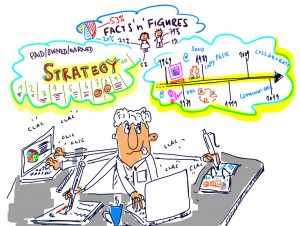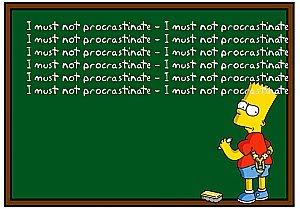Why Getting Out Of Your Comfort Zone Is A Bad Idea: Part 1 [Video]
Video Transcript
Josh Matthews-Morgan: Today I’m going to talk about comfort zones. Now, you’ve probably heard the old wisdom that in, order to grow and to go after what you really want in life, you have to push yourself out of your comfort zone. But today I’m going to tell you that sometimes it’s really not the best advice. Continue reading Why Getting Out Of Your Comfort Zone Is A Bad Idea: Part 1 [Video]
When Change Is Tough: How Your Elephant Tramples Your Success [Video]
Video Transcript
Josh Matthews-Morgan: Today we’re going to talk about why making a change is sometimes so hard. See, most people go about it like this: they think that, to make a change, you have to give yourself or give the person you’re trying to help change, lots of reasons why you should make that change. Continue reading When Change Is Tough: How Your Elephant Tramples Your Success [Video]
Want to Feel Better Than Everyone Else? Don’t Compare Yourself to Others! [Video]
Video Transcript
Nita Matthews-Morgan: Ok, so today I’m going to talk about why we compare ourselves to others even though it feels really bad. Now I’m going to tell you before I explain that that the only comparison we should be making is where we are now and where we’re going. It’s really safer to stay out of other people’s heads… Continue reading Want to Feel Better Than Everyone Else? Don’t Compare Yourself to Others! [Video]
There Are 1,000 Things You Can’t Control and Only ONE Thing You Can [Video]
Video Transcript
Josh Matthews-Morgan: So today I’m going to talk about one secret behind the mindset of peak performers. Put simply, they don’t try to control things that they can’t control.
See there’s lots of things, in life and business, that you can’t control. And if you go around trying to fix conditions, trying to fix people and circumstances that are way out of your control, you’ll just make yourself sort of crazy. Continue reading There Are 1,000 Things You Can’t Control and Only ONE Thing You Can [Video]
Don’t Kid Yourself: More Sales Training Isn’t The Answer [Video]
Video Transcript
Nita Matthews-Morgan: Hi, my name is Dr. Nita Matthews-Morgan and I want to talk to you a little bit about a problem that we have with sales people and the sales world.
You see, there’s a big gap between the training that sales people receive and what they really implement. Continue reading Don’t Kid Yourself: More Sales Training Isn’t The Answer [Video]
7 Things Your Body Needs to Ace Your Exams

Earlier this week, we published a post with seven general tips to help you study that you may not already know about. Since studying for finals can be stressful on your brain, we want to show you a few unique ways to boost your brainpower during this crucial time.
Here are seven tips that will help your body (and brain!) function at their best:
1. Drink lots of water.
The brain is a complex electrical system that uses water to transmit information. You need plenty of water to learn and to stay focused. Drink coffee and energy drinks if you need to, but just remember that caffeine is a diuretic–it makes you go to the bathroom more often, which will dehydrate you if you don’t replace the water.
2. Chew gum while you study.
Chewing gum while you study can increase your brainpower because the chewing motion increases bloodflow to your brain. It’s also a really good idea to chew gum right before your take your test. (Quick note: peppermint and cinnamon both make you more alert, so reach for a stick of Wrigley’s Big Red or Doublemint.)
3. Take a 10 minute break for every 50 minutes of work.
According to the Dartmouth Academic Research Center, you should study in 20-50 minute increments and give yourself a 5 to 10 minute break between each session
4. Move during your breaks.
Go for a quick walk if you can on your breaks. Swing your arms across the mid-line of your body like you are power-walking to turn on both sides of your brain. If you don’t have the space, you can do this standing in place.
5. Lengthen the muscles in the back of your body.
Take a minute or two to stretch out your hamstrings and lower back. The muscles in the back of your body tighten up when you sit too long. Tight muscles leads to unfocused minds.
Here’s one easy exercise you can do: Extend your legs in front of you while you’re sitting and cross one ankle over the other. Then, lean over your legs and reach towards your feet with extended arms.

6. Use all your senses when you study.
Using all your senses helps create more pathways in the brain. Try using diagrams and mind maps with colors. Write out your notes to get your tactile sense involved. Marching around the room while speaking out loud can help you memorize facts.
7. Don’t listen to music with words.
When you listen to music with words, even in the background, the lyrics compete with the information you’re trying to learn. If you like listening to music while studying, choose instrumental or classical music like Mozart.
Put a few of these tips to good use and then tell us which ones worked best for you! And feel free to share with your friends if these tips are helpful for you.
Woman drinking water image and woman hearing image via photoxpress.com
The 7 Surprising Study Tips that You Don’t Already Know
 You’ve probably already heard some of the typical advice about studying: start one full week ahead so you don’t cram, make a study plan, study in concentrated chunks over time, use study cards, rewrite your notes, study in an environment where you can concentrate, etc.
You’ve probably already heard some of the typical advice about studying: start one full week ahead so you don’t cram, make a study plan, study in concentrated chunks over time, use study cards, rewrite your notes, study in an environment where you can concentrate, etc.
But here are seven tips you probably have never heard of:
- Don’t multitask. Shut off all distractions. Turn off your phone, even shut off your internet if you feel too tempted. (You can use computer programs like Freedom and Leechblock to make Facebook and other sites impossible to access for part of the day.) Multitasking splits your brain’s resources so you can’t process information as well. In fact, research shows that if you multitask all the time, it actually changes your brain permanently so that you lose the ability to focus deeply on a task.
- Ask your professor or TA for help. Even stop by the office during office hours. Most students are afraid of bothering their professors or TA’s if they go to office hours. The opposite is usually true. When I was a professor, students who came to me during office hours struck me as serious students who were engaged in their learning.
- Predict your test questions. Test yourself by reciting and/or writing out possible answers to questions. Even if you don’t predict the right questions, putting yourself in your professor’s shoes will help deepen your understanding of the material.
- Use mind-mapping. Mind mapping is the most effective way of reviewing your notes if you’re a visual learner because it helps organize all the details into a structure you can understand.

- Review your notes before your sleep. Sleeping after you read something is proven to help you remember the information more clearly the next day. This doesn’t mean you should cram it all in the day before. But a quick refresher the night before your test will help you remember more.
- Study in different locations. Rather than sticking to one study spot, you should switch things up when reviewing for exams. Simply alternating the room where you study helps you remember better. That’s because learning in different environments forces the brain to make multiple associations with the same material, which helps you remember information for longer.
- Use your mind to imagine success. There are lots of ways to lower your anxiety on test day. But here’s a really powerful tip: Spend some time before the exam imagining yourself acing it. Play a movie in your mind, imagining everything going great from the moment you wake up on the day of the exam to the moment you finish the exam.
Put these tips into action while you study. And then leave us a comment below to tell us which one helps you the most!
Source: mindmap image via dmje
multitasking image via stoneysteiner
Cure for Procrastination? Forgive yourself!
 There are so many things you’d rather be doing than what you ought to be doing and what happens is that you delay doing what you ought. All the evidence shows that this procrastination is bad for you, for your productivity, even for your health. But still we keep putting things off. Until. Tomorrow. Now Michael Wohl and colleagues have proposed a rather surprising cure – self-forgiveness. That’s right, forgive yourself for you have procrastinated, move on, get over it and you’ll be more likely to get going without delay next time around.
There are so many things you’d rather be doing than what you ought to be doing and what happens is that you delay doing what you ought. All the evidence shows that this procrastination is bad for you, for your productivity, even for your health. But still we keep putting things off. Until. Tomorrow. Now Michael Wohl and colleagues have proposed a rather surprising cure – self-forgiveness. That’s right, forgive yourself for you have procrastinated, move on, get over it and you’ll be more likely to get going without delay next time around.Wohl’s team followed 134 first year undergrads through their first mid-term exams to just after their second lot of mid-terms. Before the initial exams, the students reported how much they’d procrastinated with their revision and how much they’d forgiven themselves. Next, midway between these exams and the second lot, the students reported how positive or negative they were feeling. Finally, just before the second round of mid-terms, the students once more reported how much they had procrastinated in their exam preparations.
The key finding was that students who’d forgiven themselves for their initial bout of procrastination subsequently showed less negative affect in the intermediate period between exams and were less likely to procrastinate before the second round of exams. Crucially, self-forgiveness wasn’t related to performance in the first set of exams but it did predict better performance in the second set.
‘Forgiveness allows the individual to move past maladaptive behaviour and focus on the upcoming examination without the burden of past acts to hinder studying,’ the researchers said. ‘By realising that procrastination was a transgression against the self and letting go of negative affect associated with the transgression via self-forgiveness, the student is able to constructively approach studying for the next exam.’
http://bps-research-digest.blogspot.com/2010/05/cure-for-procrastination-forgive.html?The cure for procrastination? Forgive yourself!
_________________________________
Five ways to get moving when you’re procrastinating
- Do contralateral moves, such as marching in place, lifting your knees up and touching your opposite knee with your opposite hand. This helps activate both sides of the brain. You need both hemispheres to be able to get ideas and also implement them. When you are blocked you tend to be using only one hemisphere.
- Visualize yourself doing what you need to do. Studies show that even when you visualize doing something without actually doing it you activate the necessary muscles and the necessary parts of the brain. If you are procrastinating about doing something just visualize yourself doing it. See yourself smiling while you are doing it.
- Notice your self talk. When you are telling yourself harsh things about feeling blocked and not being able to get started you respond as you did in the past to an authority figure. You may avoid and procrastinate. Notice your behavior without the story. The stories might include “I’m such a failure because….”, “I can’t believe that I can’t…..” The stories we tell ourselves about our perceived failure to act keep us in the resistance and what we resist, persists. Just notice what we are doing without the judgement: “ I notice I’m sitting here wasting time and not starting to do what I want to do”. Without the story we are more likely to be able to get in touch with what we need to be able to move forward. Is it more information, more resources, more focus? Pretend you are a person who comes to you and says, “I’m procrastinating and can’t get started”. What would you tell this person? Now tell yourself this.
- Pick one small thing you could do this very minute and do it. Do it just for the pleasure of doing it. Shut off all voices of judgment that what you’re doing is not big enough or important enough. After you finish doing this, make another very small goal and do it. Usually when we’re blocked we don’t see how we can do the task because we feel that we have to do it all perfectly or all at once. We forget that all tasks are composed of smaller steps.
- It’s helpful to do some free-flow writing. Just write about anything that comes to mind. If you feel blocked about writing then draw some magic eights on a piece of paper. Draw a large eight on its side by going first to the left and then to the right. Keep your eyes focused on the tip of your pencil while you keep your head still. Allow only your eyes to move across the paper. What you need to be focused on is the eye activation of moving your eyes across the visual midfield. Now do a couple of magic eights and then print an “a” on the left side of the eight. Next do two more magic eights and print a “b” on the right side of the eight. Next do 2 more magic eights and print a “c” on the left side. You will find that your ideas will start flowing as you draw these letters. You can do other letters of the alphabet in the same way.
